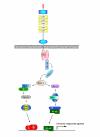The innate immune repertoire in cnidaria--ancestral complexity and stochastic gene loss
- PMID: 17437634
- PMCID: PMC1896004
- DOI: 10.1186/gb-2007-8-4-r59
The innate immune repertoire in cnidaria--ancestral complexity and stochastic gene loss
Abstract
Background: Characterization of the innate immune repertoire of extant cnidarians is of both fundamental and applied interest--it not only provides insights into the basic immunological 'tool kit' of the common ancestor of all animals, but is also likely to be important in understanding the global decline of coral reefs that is presently occurring. Recently, whole genome sequences became available for two cnidarians, Hydra magnipapillata and Nematostella vectensis, and large expressed sequence tag (EST) datasets are available for these and for the coral Acropora millepora.
Results: To better understand the basis of innate immunity in cnidarians, we scanned the available EST and genomic resources for some of the key components of the vertebrate innate immune repertoire, focusing on the Toll/Toll-like receptor (TLR) and complement pathways. A canonical Toll/TLR pathway is present in representatives of the basal cnidarian class Anthozoa, but neither a classic Toll/TLR receptor nor a conventional nuclear factor (NF)-kappaB could be identified in the anthozoan Hydra. Moreover, the detection of complement C3 and several membrane attack complex/perforin domain (MAC/PF) proteins suggests that a prototypic complement effector pathway may exist in anthozoans, but not in hydrozoans. Together with data for several other gene families, this implies that Hydra may have undergone substantial secondary gene loss during evolution. Such losses are not confined to Hydra, however, and at least one MAC/PF gene appears to have been lost from Nematostella.
Conclusion: Consideration of these patterns of gene distribution underscores the likely significance of gene loss during animal evolution whilst indicating ancient origins for many components of the vertebrate innate immune system.
Figures





References
Publication types
MeSH terms
Substances
LinkOut - more resources
Full Text Sources
Research Materials
Miscellaneous

